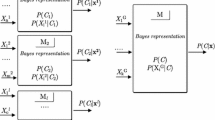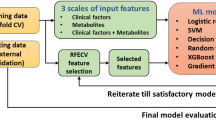Abstract
In view of high mortality associated with coronary artery disease (CAD), development of an early predicting tool will be beneficial in reducing the burden of the disease. The database comprising demographic, conventional, folate/xenobiotic genetic risk factors of 648 subjects (364 cases of CAD and 284 healthy controls) was used as the basis to develop CAD risk and percentage stenosis prediction models using ensemble machine learning algorithms (EMLA), multifactor dimensionality reduction (MDR) and recursive partitioning (RP). The EMLA model showed better performance than other models in disease (89.3%) and stenosis prediction (82.5%). This model depicted hypertension and alcohol intake as the key predictors of CAD risk followed by cSHMT C1420T, GCPII C1561T, diabetes, GSTT1, CYP1A1 m2, TYMs 5′-UTR 28 bp tandem repeat and MTRR A66G. MDR and RP models are in agreement in projecting increasing age, hypertension and cSHMTC1420T as the key determinants interacting in modulating CAD risk. Receiver operating characteristic curves exhibited clinical utility of the developed models in the following order: EMLA (C = 0.96) > RP (C = 0.83) > MDR (C = 0.80). The stenosis prediction model showed that xenobiotic pathway genetic variants i.e. CYP1A1 m2 and GSTT1 are the key determinants of percentage of stenosis. Diabetes, diet, alcohol intake, hypertension and MTRR A66G are the other determinants of stenosis. These eleven variables contribute towards 82.5% stenosis. To conclude, the EMLA model exhibited higher predictability both in terms of disease prediction and stenosis prediction. This can be attributed to higher number of iterations in EMLA model that can increase the prediction accuracy.





Similar content being viewed by others
References
Adam AM, Rehan A, Waseem N, Iqbal U, Saleem H, Ali MA, Shaikh AT, Godil A (2017) Prevalence of conventional risk factors and evaluation of baseline indices among young and elderly patients with coronary artery disease. J Clin Diagn Res 11(7):OC34–OC39
Mager A, Orvin K, Koren-Morag N, Lev IE, Assali A, Kornowski R, Shohat M, Battler A, Hasdai D (2009) Impact of homocysteine-lowering vitamin therapy on long-term outcome of patients with coronary artery disease. Am J Cardiol 104(6):745–749
Loehrer FM, Angst CP, Haefeli WE, Jordan PP, Ritz R, Fowler B (1996) Low whole-blood S-adenosylmethionine and correlation between 5-methyltetrahydrofolate and homocysteine in coronary artery disease. Arterioscler Thromb Vasc Biol 16(6):727–733
Post WS, Goldschmidt-Clermont PJ, Wilhide CC, Heldman AW, Sussman MS, Ouyang P, Milliken EE, Issa JP (1999) Methylation of the estrogen receptor gene is associated with aging and atherosclerosis in the cardiovascular system. Cardiovasc Res 43(4):985–991
Sedding DG, Tröbs M, Reich F, Walker G, Fink L, Haberbosch W, Rau W, Tillmanns H, Preissner KT, Bohle RM, Langheinrich AC (2009) 3-Deazaadenosine prevents smooth muscle cell proliferation and neointima formation by interfering with Ras signaling. Circ Res 104(10):1192–1200
Kim YR, Kim CS, Naqvi A, Kumar A, Kumar S, Hoffman TA, Irani K (2012) Epigenetic upregulation of p66shc mediates low-density lipoprotein cholesterol-induced endothelial cell dysfunction. Am J Physiol Heart Circ Physiol 303(2):H189–H196
Guay SP, Brisson D, Munger J, Lamarche B, Gaudet D, Bouchard L (2012) ABCA1 gene promoter DNA methylation is associated with HDL particle profile and coronary artery disease in familial hypercholesterolemia. Epigenetics 7(5):464–472
Chang PY, Chen YJ, Chang FH, Lu J, Huang WH, Yang TC, Lee YT, Chang SF, Lu SC, Chen CH (2013) Aspirin protects human coronary artery endothelial cells against atherogenic electronegative LDL via an epigenetic mechanism: a novel cytoprotective role of aspirin in acute myocardial infarction. Cardiovasc Res 99(1):137–145
Guay SP, Brisson D, Lamarche B, Gaudet D, Bouchard L (2014) Epipolymorphisms within lipoprotein genes contribute independently to plasma lipid levels in familial hypercholesterolemia. Epigenetics 9(5):718–729
Niu PP, Cao Y, Gong T, Guo JH, Zhang BK, Jia SJ (2014) Hypermethylation of DDAH2 promoter contributes to the dysfunction of endothelial progenitor cells in coronary artery disease patients. J Transl Med 12:170
Fiorito G, Guarrera S, Valle C, Ricceri F, Russo A, Grioni S, Mattiello A, Di Gaetano C, Rosa F, Modica F, Iacoviello L, Frasca G, Tumino R, Krogh V, Panico S, Vineis P, Sacerdote C, Matullo G (2014) B-vitamins intake, DNA-methylation of one carbon metabolism and homocysteine pathway genes and myocardial infarction risk: the EPICOR study. Nutr Metab Cardiovasc Dis 24(5):483–488
Lakshmi SV, Naushad SM, Reddy CA, Saumya K, Rao DS, Kotamraju S, Kutala VK (2013) Oxidative stress in coronary artery disease: epigenetic perspective. Mol Cell Biochem 374(1–2):203–211
Vijaya Lakshmi SV, Naushad SM, Rupasree Y, Seshagiri Rao D, Kutala VK (2011) Interactions of 5′-UTR thymidylate synthase polymorphism with 677C → T methylene tetrahydrofolate reductase and 66A → G methyltetrahydrofolate homocysteine methyl-transferase reductase polymorphisms determine susceptibility to coronary artery disease. J Atheroscler Thromb 18(1):56–64
Lakshmi SV, Naushad SM, Saumya K, Rao DS, Kutala VK (2012) Role of CYP1A1 haplotypes in modulating susceptibility to coronary artery disease. Indian J Biochem Biophys 49(5):349–355
Sanvisens A, Zuluaga P, Pineda M, Fuster D, Bolao F, Juncà J, Tor J, Muga R (2017) Folate deficiency in patients seeking treatment of alcohol use disorder. Drug Alcohol Depend 180:417–422
Naushad SM, Radha Rama Devi A, Nivetha S, Lakshmitha G, Stanley AB, Hussain T, Kutala VK (2017) Neurofuzzy model of homocysteine metabolism. J Genet 96(6):919–926
Yamada K, Chen Z, Rozen R, Matthews RG (2001) Effects of common polymorphisms on the properties of recombinant human methylenetetrahydrofolate reductase. Proc Natl Acad Sci USA 98(26):14853–14858
Tanis BC, Blom HJ, Bloemenkamp DG, van den Bosch MA, Algra A, van der Graaf Y, Rosendaal FR (2004) Folate, homocysteine levels, methylenetetrahydrofolate reductase (MTHFR) 677C --> T variant, and the risk of myocardial infarction in young women: effect of female hormones on homocysteine levels. J Thromb Haemost 2(1):35–41
George J, Ahmed A, Patnaik M, Adler Y, Levy Y, Harats D, Gilburd B, Terrybery J, Shen GQ, Sagie A, Herz I, Snow P, Brandt J, Peter J, Shoenfeld Y (2000) The prediction of coronary atherosclerosis employing artificial neural networks. Clin Cardiol 23(6):453–456
She J, Deng Y, Wu Y, Xia Y, Li H, Liang X, Shi R, Yuan Z (2017) Hemoglobin A1c is associated with severity of coronary artery stenosis but not with long term clinical outcomes in diabetic and nondiabetic patients with acute myocardial infarction undergoing primary angioplasty. Cardiovasc Diabetol 16(1):97
Edlinger M, Wanitschek M, Dörler J, Ulmer H, Alber HF, Steyerberg EW (2017) External validation and extension of a diagnostic model for obstructive coronary artery disease: a cross-sectional predictive evaluation in 4888 patients of the Austrian Coronary Artery disease Risk Determination In Innsbruck by diaGnostic ANgiography (CARDIIGAN) cohort. BMJ Open 7(4):e014467
Vijaya Lakshmi SV, Naushad SM, Seshagiri Rao D, Kutala VK (2013) Oxidative stress is associated with genetic polymorphisms in one-carbon metabolism in coronary artery disease. Cell Biochem Biophys 67(2):353–361
Sun K, Song J, Liu K, Fang K, Wang L, Wang X, Li J, Tang X, Wu Y, Qin X, Wu T, Gao P, Chen D, Hu Y (2017) Associations between homocysteine metabolism related SNPs and carotid intima-media thickness: a Chinese sib pair study. J Thromb Thrombolysis 43(3):401–410
Nilsson BB, Lunde P, Grøgaard HK, Holm I (2018) Long-term results of high-intensity exercise-based cardiac rehabilitation in revascularized patients for symptomatic coronary artery disease. Am J Cardiol 121(1):21–26
Acknowledgements
The authors extend their appreciation to the Deanship of Scientific Research at King Saud University for funding this work through research Group No. (RG-1435-066).
Author information
Authors and Affiliations
Corresponding author
Ethics declarations
Conflict of interest
None of the authors has a financial or other relationship with other people or organizations that may inappropriately influence this work.
Ethical approval
The study protocol was approved by Institutional Ethical committee of Nizam’s Institute of Medical Sciences, Hyderabad. This study complied with the ethical principles outlined in the Declaration of Helsinki.
Informed consent
Informed consent was obtained from all the study participants (cases as well as controls) during their enrollment for the study.
Electronic supplementary material
Below is the link to the electronic supplementary material.
Rights and permissions
About this article
Cite this article
Naushad, S.M., Hussain, T., Indumathi, B. et al. Machine learning algorithm-based risk prediction model of coronary artery disease. Mol Biol Rep 45, 901–910 (2018). https://doi.org/10.1007/s11033-018-4236-2
Received:
Accepted:
Published:
Issue Date:
DOI: https://doi.org/10.1007/s11033-018-4236-2




